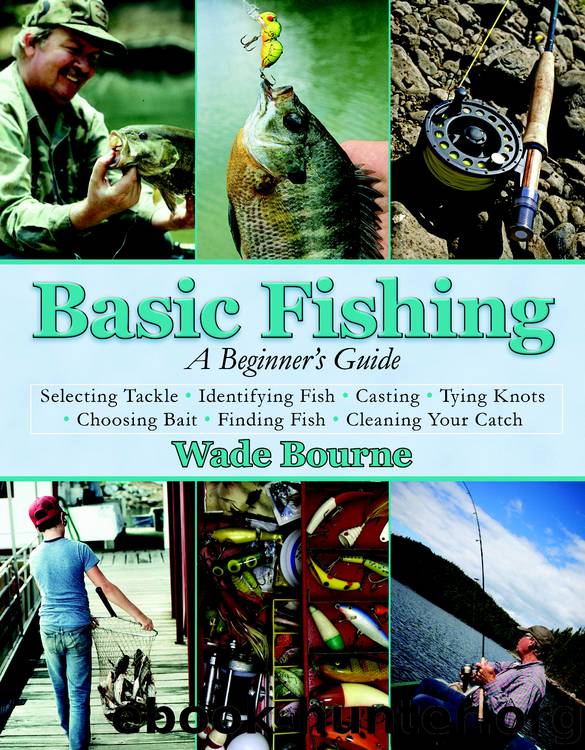Basic Fishing by Wade Bourne

Author:Wade Bourne
Language: eng
Format: epub
Publisher: Skyhorse Publishing, Inc.
Published: 2011-04-27T16:00:00+00:00
Ponds and small lakes are plentiful throughout North America, and many offer very good action on fish that rarely see baits or artificial lures. These diminutive waters are great places for beginners to learn the basics of this sport.
When you see these “beds,” set your bobber shallow and drop your bait right next to them, trying not to spook the fish. You’re probably better off casting into the beds rather than sneaking in close with a long pole.
CRAPPIE
Fishing for crappie in ponds and small lakes is similar to fishing for bluegill and sunfish. Always fish close to structure and stay on the move until you find fish. The primary difference is the bait you use. Crappie prefer minnows over other natural baits, and they readily attack small jigs and spinners.
Long poles are a favorite with crappie fishermen. Many crappie experts quietly skull a small boat from one piece of structure to the next, and use a panfish pole to dangle a float rig with a minnow or jig in next to cover. They ease their bait down beside a tree or piece of brush, leave it for a moment, pick it up, set it down on the other side, then move to the next spot. In small lakes and ponds, crappie scatter throughout the shallow structure, and this “hunt-and-peck” method of fishing is very effective. This is especially true in spring, when the fish move into shallow cover to spawn. You can also use this method while wade-fishing or fishing from shore, if the structure is within reach.
Another good crappie technique is to use a slip-bobber rig with a spinning or spin-cast outfit. Hook a live minnow through the back onto a thin wire hook (#2) or through the lips on a lightweight ( or ounce) jig. Then cast this rig next to a weedline, brushpile or log.
If you don’t get a bite in 5 minutes, try somewhere else. If you get a bite, don’t yank if the bobber is just twitching. Wait for the bobber to start moving off or disappear beneath the surface before setting the hook. Crappie have soft mouths, so don’t set too hard, or you’ll rip out the hook. Instead, lift up on your pole or rod, and you should have the fish.
If you don’t catch fish shallow, try deeper water, especially during hot summer months or on bright, clear days. Adjust your bobber up the line and drop your bait right in front of the dam or off the end of a pier. Try casting into the middle of the pond and see what happens. With this method of fishing, 6-10 feet is not too deep. There is less certainty in this technique, however, because you’re hunting for crappie in a random area.
Download
This site does not store any files on its server. We only index and link to content provided by other sites. Please contact the content providers to delete copyright contents if any and email us, we'll remove relevant links or contents immediately.
Backpacker the Complete Guide to Backpacking by Backpacker Magazine(2213)
Capital in the Twenty-First Century by Thomas Piketty(1982)
The Isle of Mull by Terry Marsh(1919)
Predation ID Manual by Kurt Alt(1669)
The Collected Non-Fiction by George Orwell(1592)
Small-Bore Rifles by C. Rodney James(1516)
All Fishermen Are Liars by John Gierach(1462)
Backcountry Bear Basics by Dave Smith(1450)
Creative Confidence by Tom Kelley(1427)
The Art of Throwing by Amante P. Marinas Sr(1372)
50 Famous Firearms You've Got to Own by Rick Hacker(1355)
Blood Mountain by J.T. Warren(1316)
Archery: The Art of Repetition by Simon Needham(1315)
Long Distance Walking in Britain by Damian Hall(1291)
The Scouting Guide to Survival by The Boy Scouts of America(1269)
Backpacker Long Trails by Backpacker Magazine(1257)
The Fair Chase by Philip Dray(1240)
The Real Wolf by Ted B. Lyon & Will N. Graves(1223)
The Ultimate Guide to Home Butchering by Monte Burch(1216)
